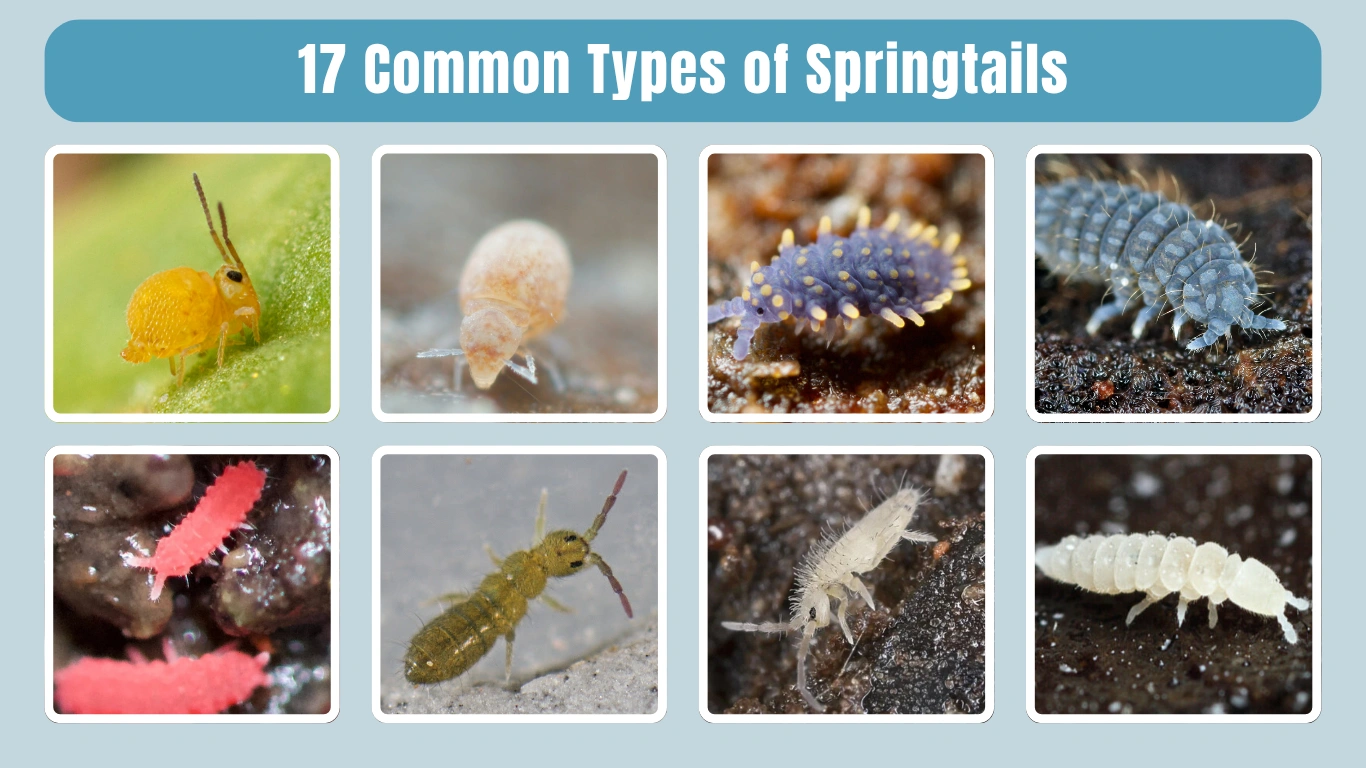Springtails are tiny, jumping insects that thrive in moist environments and play a vital role in soil health and decomposition. With hundreds of species worldwide, they vary in shape, color, and habitat—from snow-covered forests to coastal rocks and even deep caves. In this guide, you’ll discover 17 common types of springtails, complete with identification tips, habitat details, and their unique roles in the ecosystem.
1. Snow Flea (Hypogastrura nivicola)
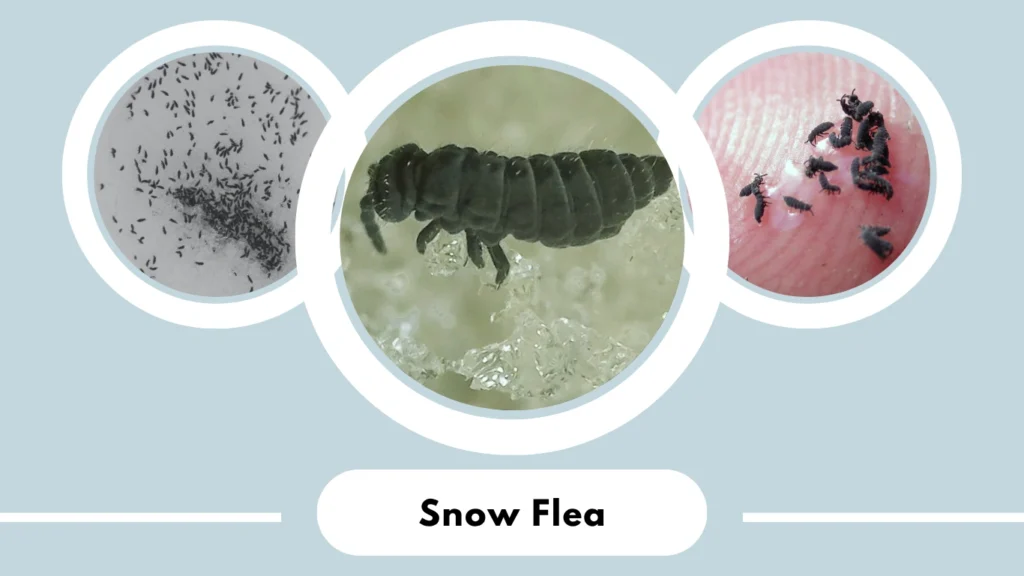
The Snow Flea is a tiny, dark-colored springtail often spotted on the surface of snow during late winter or early spring. Despite the name, it’s not an actual flea—it doesn’t bite or harm animals. These springtails are known for their remarkable cold resistance and ability to survive freezing temperatures thanks to a natural antifreeze protein in their bodies. They’re commonly found in forested areas under leaf litter, logs, or snow.
Identification
- Color: Dark blue to black
- Size: About 1–2 mm long
- Shape: Oval or globular body
- Movement: Can jump short distances using a furcula
- Location: Often found on melting snow or beneath leaf litter
Habitat
Snow Fleas live in moist, decaying environments like leaf litter, moss, or soil. In winter, they appear on snow surfaces where the temperature and moisture balance allows activity.
Behavior and Diet
These springtails feed on decaying organic matter, fungi, algae, and bacteria. They play an important role in decomposing plant material and recycling nutrients in the soil.
Role in the Ecosystem
Snow Fleas are beneficial for soil health. By breaking down organic matter, they contribute to soil fertility and structure, supporting plant growth.
2. Garden Springtail (Bourletiella hortensis)
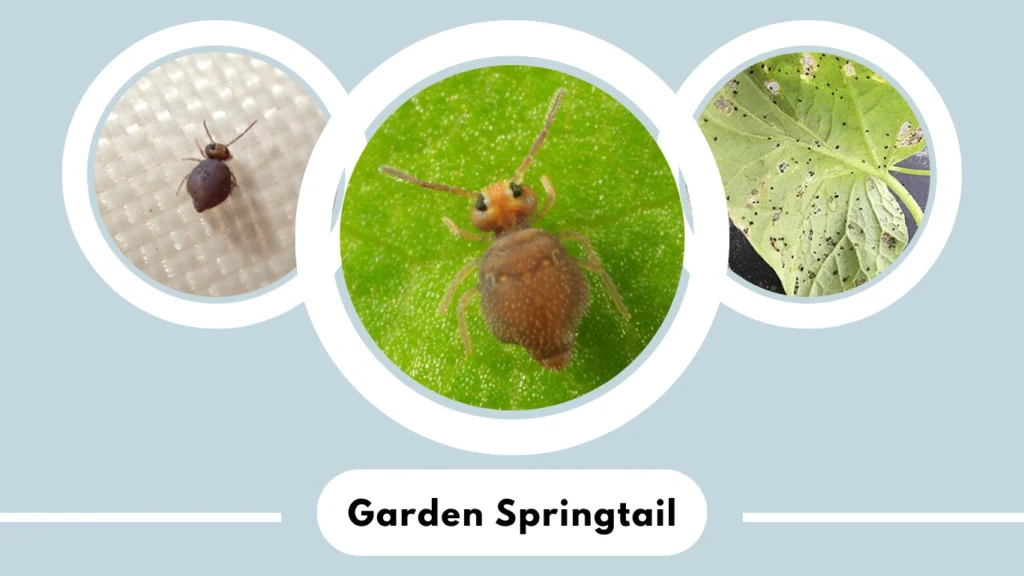
The Garden Springtail is a fast-moving, surface-dwelling species often seen in gardens, compost heaps, and moist soil. These tiny insects are beneficial to garden ecosystems, helping to break down organic matter. They’re usually active during warm, damp weather and may appear in large numbers when soil is disturbed.
Identification
- Color: Grayish to purplish-brown
- Size: Around 1–1.5 mm
- Shape: Compact, globular body
- Movement: Rapid jumping when disturbed
- Location: Garden beds, potted soil, compost
Habitat
Prefers moist, nutrient-rich environments like compost, garden beds, and mulch layers. They thrive in areas with decaying plant material.
Behavior and Diet
Feeds on decomposing leaves, fungi, algae, and organic debris. They are important contributors to nutrient cycling in garden ecosystems.
Role in the Ecosystem
These springtails assist in soil aeration and nutrient release. Their activity supports healthy root systems and natural composting processes.
3. Globular Springtail (Dicyrtomina minuta)
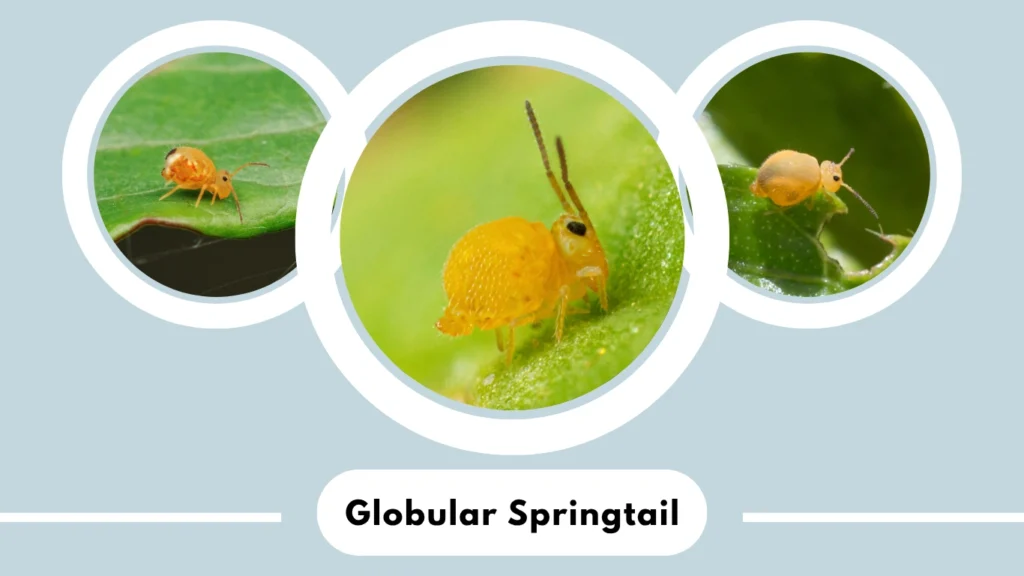
Globular Springtails are among the most visually striking of springtail species due to their colorful patterns and round shape. Commonly found on decaying logs, moss, or leaf litter, they are small but play a major role in organic decomposition.
Identification
- Color: Yellow, purple, or mottled with brown patches
- Size: About 1–2 mm
- Shape: Distinctly round or spherical body
- Movement: Agile jumpers using their furcula
- Location: Forest floor, under bark, moist wood
Habitat
Found in forests, gardens, and moist shaded environments. They are particularly drawn to decaying wood and mossy surfaces.
Behavior and Diet
Consumes fungal spores, algae, and rotting vegetation. They contribute significantly to the decomposition process in forest floors.
Role in the Ecosystem
These springtails help maintain soil health by accelerating the breakdown of organic material. Their presence is an indicator of a healthy, biodiverse micro-ecosystem.
4. Elongate Springtail (Entomobrya nivalis)
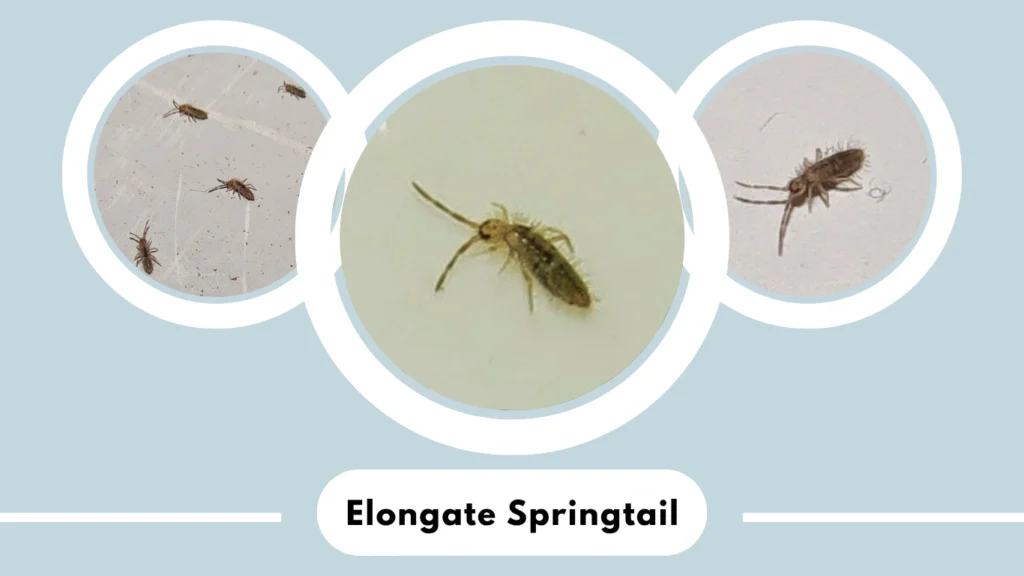
The Elongate Springtail is one of the most commonly observed species in the Entomobryidae family. It has a slender body and often features colorful banding. These springtails are frequently found on tree bark, leaf litter, and even snow surfaces in colder climates.
Identification
- Color: Light brown with white or dark banding
- Size: 2–3 mm
- Shape: Long, slender body
- Movement: Jumps quickly when disturbed
- Location: Forests, gardens, moss, snow
Habitat
Prefers moist environments like under bark, in leaf litter, and near decaying vegetation. Can be active even in cold conditions, occasionally seen on snow.
Behavior and Diet
Feeds on fungi, mold, and decaying plant matter. Often aggregates in small groups near decomposing wood or organic debris.
Role in the Ecosystem
Plays a critical role in organic decomposition and fungal regulation, especially in cooler environments where few organisms remain active.
5. Slender Springtail (Orchesella cincta)

The Slender Springtail is easily recognizable by its striped body and long antennae. It’s commonly seen crawling on soil surfaces, tree bark, and beneath stones. It is very active and can jump considerable distances for its size.
Identification
- Color: Brownish with dark bands or stripes
- Size: 2–4 mm
- Shape: Elongated and narrow
- Movement: Strong jumper; fast crawler
- Location: Leaf litter, rotting logs, garden mulch
Habitat
Found in wooded areas, gardens, and under debris. It prefers damp microhabitats and thrives in compost or mulch-rich soil.
Behavior and Diet
Consumes a variety of fungi, lichen, and decaying plant materials. Sometimes climbs onto vegetation or tree trunks in search of food.
Role in the Ecosystem
Helps regulate fungal growth and accelerates the recycling of nutrients in forest floors and gardens. Its presence indicates a healthy decomposition process.
6. Common Springtail (Folsomia candida)
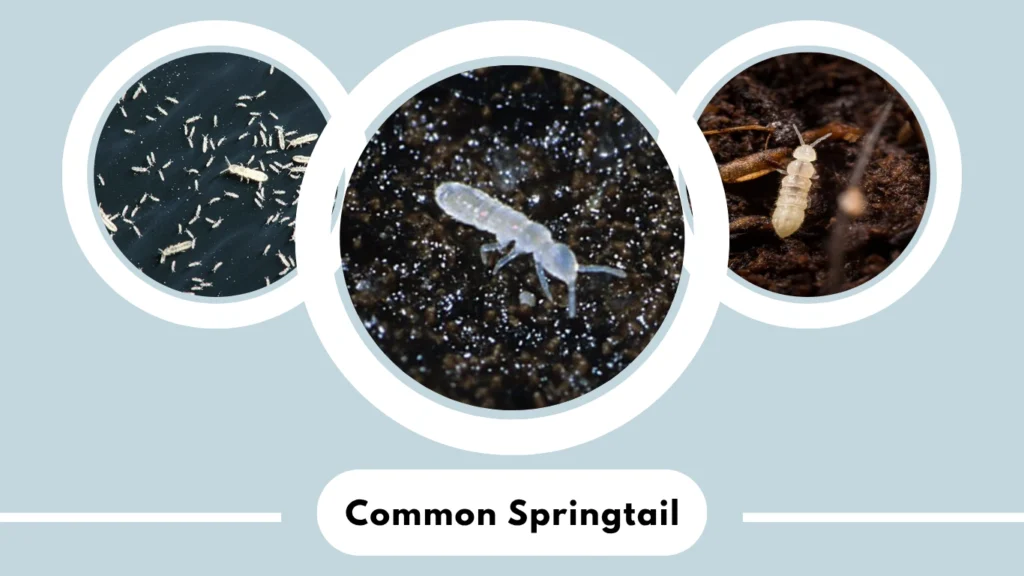
The Common Springtail is a well-studied, soil-dwelling species often used in laboratory testing due to its sensitivity to soil pollutants. It thrives in moist environments rich in decaying organic matter and plays an important role in soil health.
Identification
- Color: Pale white or light gray
- Size: About 1–2 mm
- Shape: Slender, soft-bodied
- Movement: Moderate jumper
- Location: Moist soil, compost, rotting leaves
Habitat
Prefers damp, humus-rich environments like compost bins, potting soil, and under mulch. It is often found near plant roots.
Behavior and Diet
Feeds on decaying organic material, fungi, and bacterial colonies. It’s especially useful in breaking down fine particles of compost.
Role in the Ecosystem
This springtail aids in the breakdown of organic matter, improving soil structure and nutrient availability. Its sensitivity to toxins makes it a valuable species for environmental monitoring.
7. Giant Springtail (Megalothorax minimus)
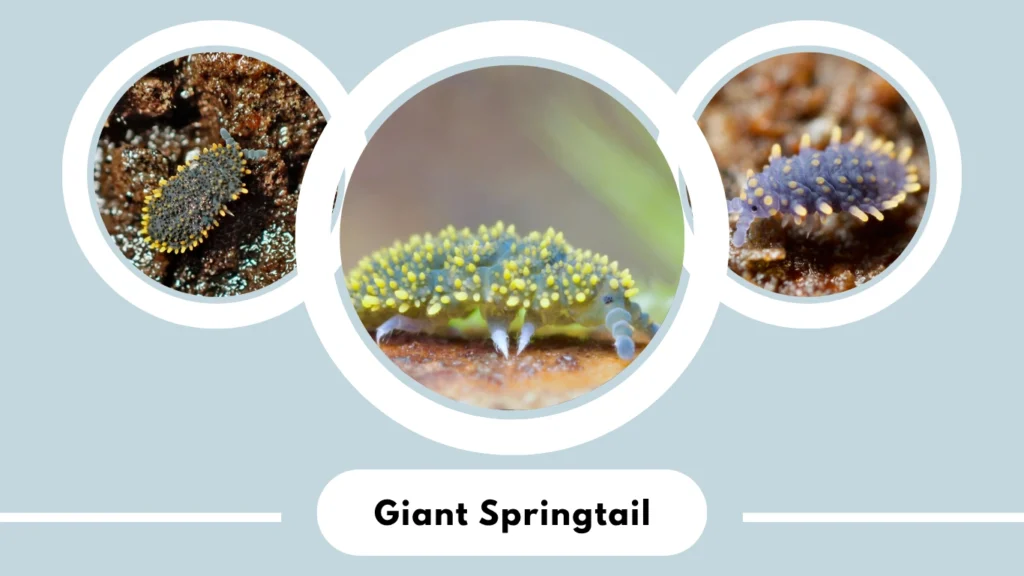
Despite its name, the Giant Springtail is actually one of the smallest springtails known—its name refers to the relatively large head and thorax compared to the rest of its body. It is often overlooked due to its size and hidden lifestyle.
Identification
- Color: Translucent or pale yellow
- Size: Less than 1 mm
- Shape: Round, compact body with large head and thorax
- Movement: Slow jumper
- Location: Deep soil layers, moss, leaf litter
Habitat
Found in damp soil, under moss mats, or deep within leaf litter. Prefers dark, humid microhabitats that retain moisture.
Behavior and Diet
Feeds on microbial biofilms, fungal spores, and fine decomposed materials. Tends to avoid light and surface exposure.
Role in the Ecosystem
Plays a hidden but vital role in soil ecology, particularly in breaking down microscopic particles and supporting microbe populations underground.
8. Coastal Springtail (Anurida maritima)

The Coastal Springtail is a unique, marine-associated springtail that thrives in intertidal zones. Unlike most springtails, it has adapted to survive salty environments and is often found on rocky shores or under seaweed along coastlines.
Identification
- Color: Dark blue to black
- Size: Around 1–2.5 mm
- Shape: Oval body, flattened slightly for crawling
- Movement: Crawls more than it jumps
- Location: Rocky shores, tide pools, under seaweed
Habitat
Lives in intertidal areas, especially on rocks, under shells, and inside decaying seaweed piles. It can tolerate brief submersion during high tide.
Behavior and Diet
Feeds on algae, decaying marine matter, and biofilms. It forms dense groups in moist, shaded shoreline areas and often moves with the tide.
Role in the Ecosystem
Acts as a decomposer in marine environments, helping break down seaweed and organic debris along coasts. It also serves as a food source for small shore predators.
9. Pink Springtail (Sminthurinus aureus)

The Pink Springtail is known for its striking coloration and small, globular body. It is commonly found in gardens and fields and often appears in large numbers on the surface of moist soil or plant leaves, especially during humid weather.
Identification
- Color: Bright pink to reddish-orange
- Size: Around 0.5–1 mm
- Shape: Round, globular body
- Movement: Active jumper
- Location: Surface of moist soil, plant leaves, flower beds
Habitat
Prefers gardens, meadows, and agricultural soils with high moisture. Often seen on the surface during early morning or after rainfall.
Behavior and Diet
Feeds on pollen, fungal spores, and organic debris. May climb low vegetation and flowers in search of food.
Role in the Ecosystem
Helps in breaking down organic material and contributes to the microbial balance in soil and on plant surfaces. Its colorful presence can be an indicator of a healthy garden ecosystem.
10. Dark Springtail (Isotoma viridis)

The Dark Springtail is a soil-dwelling species that blends easily into its environment due to its earthy coloration. It is widely distributed across gardens, forests, and farmland. These springtails are essential contributors to decomposition and are active mostly at night or in low-light areas.
Identification
- Color: Dark greenish-gray to black
- Size: Around 1.5–2 mm
- Shape: Elongated body with fine hairs
- Movement: Quick, hopping motion
- Location: Leaf litter, under logs, compost piles
Habitat
Found in moist leaf litter, topsoil, and decomposing plant matter. It prefers cool, shaded environments and is often uncovered during soil disturbance.
Behavior and Diet
Consumes fungi, algae, and decaying vegetation. Known for thriving in nutrient-rich environments and forming small surface clusters.
Role in the Ecosystem
Assists in nutrient cycling and maintains fungal populations. It is considered an important bioindicator of healthy, undisturbed soil.
11. White Springtail (Onychiurus armatus)

The White Springtail is a small, eyeless species that lives deeper in the soil compared to many other springtails. It is less mobile and does not rely on its furcula for jumping, preferring to crawl. It plays a key role in underground soil ecosystems.
Identification
- Color: White or cream
- Size: 1–1.5 mm
- Shape: Slender, soft-bodied
- Movement: Crawls, rarely jumps
- Location: Deep soil layers, under rocks or decaying logs
Habitat
Inhabits deeper, compacted soil, often in agricultural fields or beneath thick layers of organic matter. Prefers moist, oxygen-poor environments.
Behavior and Diet
Feeds on root-associated fungi, organic particles, and decayed roots. Often found near decomposing plant structures and root zones.
Role in the Ecosystem
Supports microbial activity and soil aeration at deeper levels. It helps control root fungi and enhances root-zone nutrient availability.
12. Soil Springtail (Protaphorura fimata)

The Soil Springtail is a common subterranean species that thrives in cultivated land and compost-rich soil. It lacks pigmentation and eyes, which is typical for springtails that live completely underground. It plays a vital role in soil health by aiding decomposition and stimulating microbial activity.
Identification
- Color: White to pale gray
- Size: 1.5–2 mm
- Shape: Elongated, cylindrical body
- Movement: Crawls, rarely jumps
- Location: Deep soil, compost, root zones
Habitat
Prefers dense, moist soil environments like garden beds, farmland, or compost heaps. Often found below the surface, especially in organic-rich or clay-heavy soils.
Behavior and Diet
Feeds on dead plant material, bacteria, and fungal hyphae. Plays a key role in the decomposition of plant roots and compost.
Role in the Ecosystem
Contributes to nutrient cycling and soil structure. Its feeding activity enhances soil fertility and microbial balance, which benefits root development.
13. Tree Springtail (Pogonognathellus longicornis)
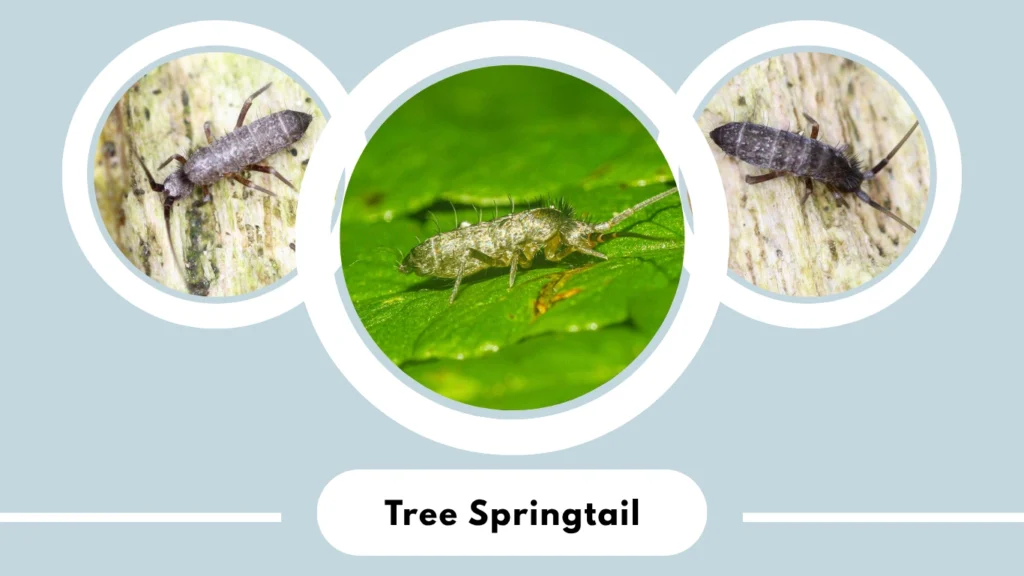
Tree Springtails are larger than most springtails and are often seen on the bark of trees, forest floors, or fallen logs. They are known for their unusually long antennae and ability to leap impressively. Their active foraging helps maintain balance in arboreal microhabitats.
Identification
- Color: Brown to dark gray
- Size: Up to 4 mm
- Shape: Slender with very long antennae
- Movement: Strong jumper, also crawls quickly
- Location: Tree bark, forest floor, mossy logs
Habitat
Found in woodlands and forested environments. Prefers moist, shaded areas with lots of bark, moss, or decaying wood to hide under.
Behavior and Diet
Eats lichen, algae, fungal spores, and rotting organic matter. Actively moves along bark and moss searching for food.
Role in the Ecosystem
Supports forest ecosystems by breaking down tree bark debris and lichen. Their presence on trees helps maintain ecological balance in upper forest layers.
14. Marsh Springtail (Isotomurus palustris)
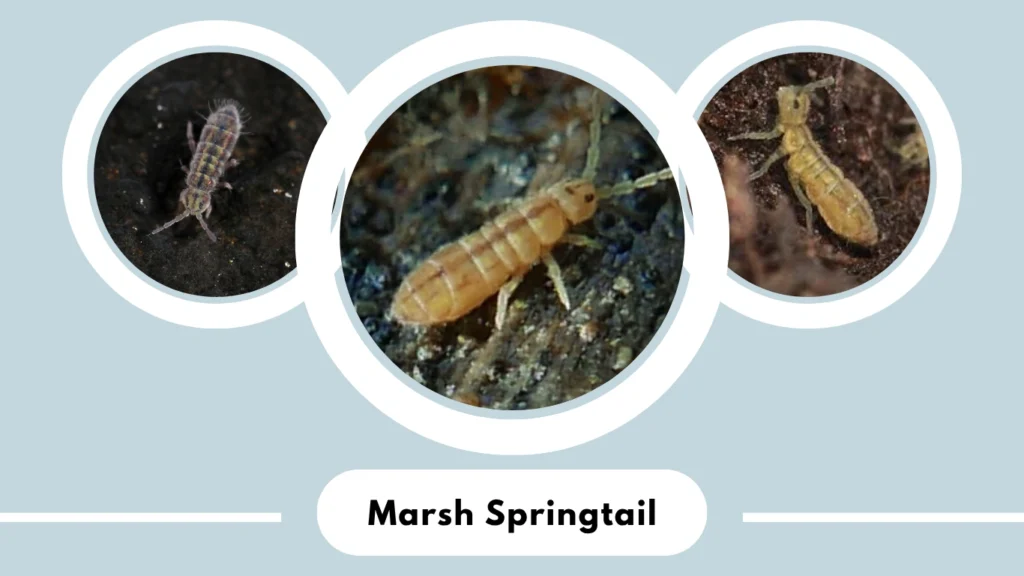
The Marsh Springtail is a moisture-loving species commonly found in wetlands, pondsides, and marshy environments. It often appears on the water’s surface or nearby mud, and its semi-aquatic nature allows it to survive in areas where most springtails wouldn’t thrive.
Identification
- Color: Pale gray to bluish
- Size: 1.5–3 mm
- Shape: Slender body with short legs
- Movement: Skips or jumps on water surface
- Location: Marshes, pond edges, saturated soil
Habitat
Prefers very damp habitats with standing or slow-moving water. Found in wet grasslands, bogs, and shallow ditches with decaying vegetation.
Behavior and Diet
Feeds on algae, bacteria, and organic residues in marshy soils and shallow water. Its ability to walk on water allows access to unique food sources.
Role in the Ecosystem
Helps recycle plant material in aquatic ecosystems and supports nutrient cycling in wetland soils. Its presence indicates a balanced, moist environment.
15. Litter Springtail (Tullbergia granulata)

The Litter Springtail is a tiny, pale species commonly found in deep leaf litter and humus layers. It’s adapted for life in darkness and is often seen when digging or turning compost or forest soil.
Identification
- Color: White to light gray
- Size: Around 1 mm
- Shape: Cylindrical with a smooth surface
- Movement: Crawls slowly, weak jumper
- Location: Leaf litter, forest soil, compost piles
Habitat
Found in shaded forest floors, rich humus, and moist compost. It prefers undisturbed organic debris and avoids light.
Behavior and Diet
Feeds on decaying leaves, fungi, and microbial colonies. Stays hidden beneath the surface, working through dense organic matter.
Role in the Ecosystem
Important for breaking down thick layers of leaf litter and contributing to rich topsoil formation. It helps build the foundational layers of forest floor ecosystems.
16. Cave Springtail (Plutomurus ortobalaganensis)

The Cave Springtail is one of the deepest-living terrestrial animals ever recorded, discovered in the Krubera Cave system in Georgia. It is uniquely adapted to life in total darkness, surviving in extreme underground environments with high humidity and low temperatures.
Identification
- Color: Pale or translucent
- Size: About 2–2.5 mm
- Shape: Elongated body with reduced pigmentation and no eyes
- Movement: Slow crawler; limited jumping ability
- Location: Deep cave environments
Habitat
Exclusively found in deep cave systems, often more than 1,000 meters below the surface. Lives in complete darkness with constant moisture and cool temperatures.
Behavior and Diet
Feeds on microbial films, decaying organic matter, and fungal growths on cave walls. It is slow-moving and relies on touch and chemical cues to navigate.
Role in the Ecosystem
Plays a key role in cave nutrient cycling, helping break down organic matter in a fragile, nutrient-scarce ecosystem. Its presence is important for cave biodiversity and ecological research.
17. Leaf Litter Springtail (Neanura muscorum)
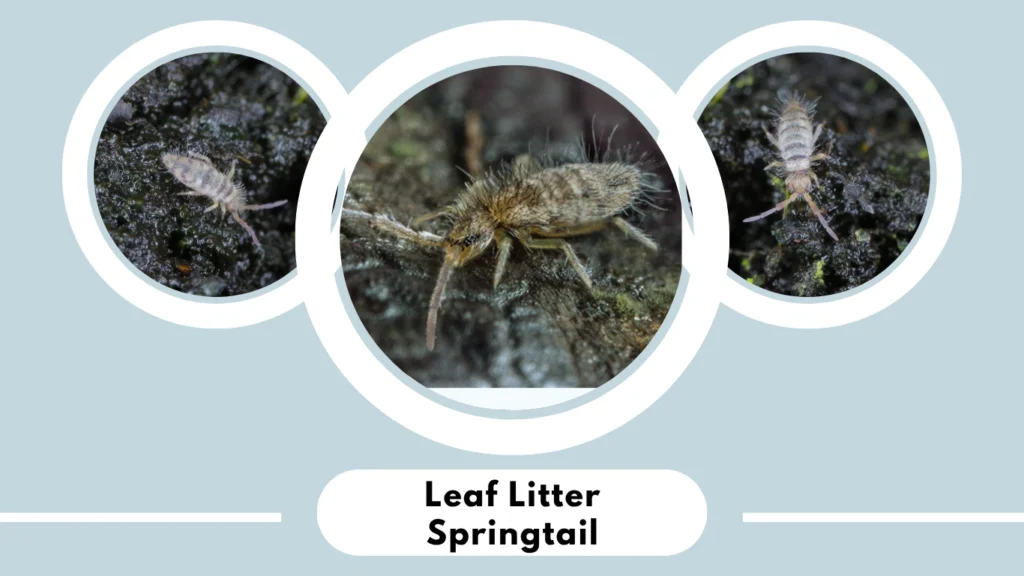
The Leaf Litter Springtail is a distinctive, rounded species often found in damp, shaded woodland floors. It lacks a furcula, so it cannot jump like other springtails and instead relies on crawling. Its warty body and bright colors make it easily recognizable.
Identification
- Color: Blue, purple, or violet with bumpy surface
- Size: 2–3 mm
- Shape: Globular, rough-textured body
- Movement: Crawls slowly; does not jump
- Location: Damp leaf litter, moss, and decaying logs
Habitat
Common in forests, especially under layers of moist leaves, mosses, and rotting wood. Prefers shaded, humid areas with dense organic debris.
Behavior and Diet
Feeds primarily on decaying vegetation and fungal hyphae. Its slow movement keeps it close to food sources within the litter layer.
Role in the Ecosystem
Acts as a recycler of organic matter, supporting the decomposition process and maintaining soil microhabitat balance in forest ecosystems. Its presence signals a moist, healthy forest floor.

